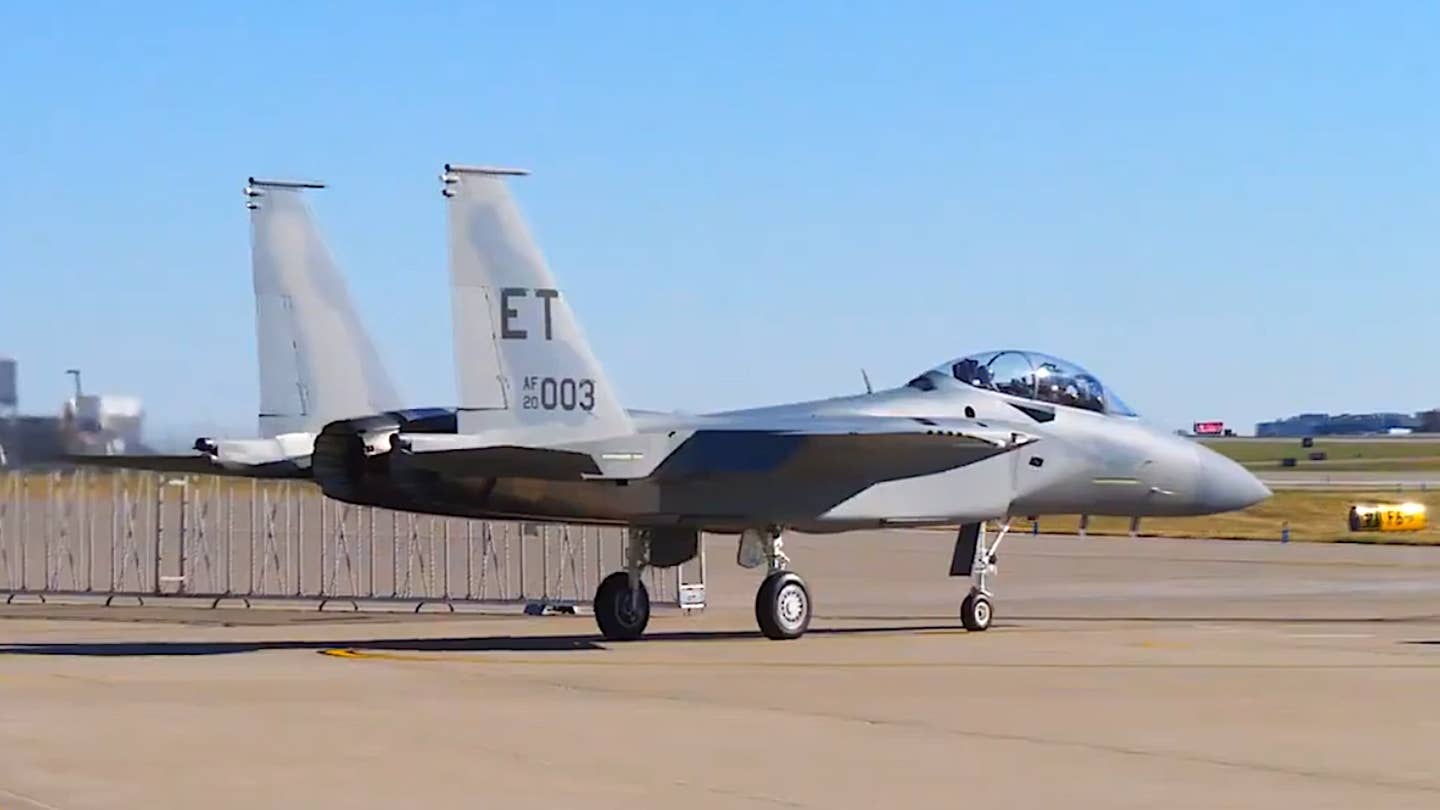The Air Force now has a total of four F-15EX Eagle IIs after a year of delays and Boeing hopes to deliver two more in the coming weeks.

A spokesperson for Boeing confirmed to The War Zone that the Air Force’s third and fourth F-15EXs, also known as EX3 and EX4, were delivered to Eglin Air Force Base in Florida today. Air Force pilots and weapon system officers (WSO) had conducted pre-delivery checkout flights on these jets earlier this month. Previous reports have also said the EX3 is the first Eagle II to be produced in the final production configuration, which includes the AN/ALQ-250 Eagle Passive Warning Survivability System (EPAWSS) electronic warfare suite.
EX3 and EX4 have now joined the Air Force’s initial pair of F-15EXs, which were delivered between March and April 2021, at Eglin. All four jets are part of an Eagle II test force.
Boeing’s spokesperson further told The War Zone today that the company hopes to deliver the next two F-15EXs to the Air Force before the end of the year. These jets will also be assigned to the test unit at Eglin.
Another two F-15EXs are currently under construction for the Air Force and are set to join the Oregon Air National Guard 142nd Fighter Wing early next year. The 142nd is set to be the first operational unit to fly the Eagle II. The Air Force currently plans to buy a total of 104 F-15EXs.
A report that the U.S. Government Accountability Office (GAO), a congressional watchdog, published earlier this year blamed the F-15EX delivery delays on manufacturing problems at Boeing and with third-party suppliers, as well as budgetary issues stemming from fluctuations in the planned Eagle II fleet size. Last year, the Air Force moved to truncate its expected purchases of F-15EX from at least 144 to just 80, before increasing that figure to 104.
It is important to note that the delays have not yet led to a formal breach of the F-15EX program’s schedule. If the Air Force receives the next four Eagle IIs between now and July of next year, it should be able to meet the official requirements to declare initial operational capability (IOC) with the type.
At the same time, the saga of delivering the second pair of F-15EXs to the Air Force, together with the fact that the service will be able to declare IOC with just two jets assigned to an operational unit, speak volumes about the now long-standing questions surrounding the plans for the Eagle II fleet. By comparison, the Air Force had 15 jets assigned to its first operational F-35A squadron when it declared IOC for that type in 2016.
As of December 2022, what it would take to achieve Full Operational Capability (FOC) with the F-15EX is just 44 jets, “along with delivery of training equipment and material, support equipment, spares, and technical data,” according to a now declassified Pentagon Selected Acquisition Report (SAR). The 2022 SAR said that the goal then was for that milestone to be achieved in September 2026, but that the official deadline was July 2027.
The US Air Force’s first two F-15EXs fly together. USAF
As it stands now, the Air Force has officially announced plans to establish three operational squadrons of F-15EXs, one each within the Oregon, California, and Louisiana Air National Guards, where they will replace aging F-15C/D Eagle fighters. The service has also formally axed plans to establish a dedicated Eagle II schoolhouse unit within the Oregon Air National Guard in favor of blending together the F-15EX and F-15E Strike Eagle training pipelines. The Oregon Air National Guard’s existing F-15C/D schoolhouse squadron is now set to transform into an F-35A training unit.
A report just this week from Japan’s Nikkei Asia news magazine said that the service is planning to forward deploy two additional squadrons of Eagle IIs to Kadena Air Base in that country. You can read more about what this might mean here. This is something The War Zone has speculated could occur in the past, especially following the announcement last year that the Air Force was shuttering a pair of F-15C/D squadrons at Kadena without any immediate plans for permanent replacements. This would also round out the assignment of all 104 F-15EXs the Air Force presently plans to acquire.
The Eagle II, with its two-person cockpit, is particularly well positioned to act as an airborne controller for the hundreds (or more likely thousands) of future Collaborative Combat Aircraft (CCA) that the service plans to acquire in the coming years. Air Force Gen. Kenneth Wilsbach, head of U.S. Pacific Air Forces (PACAF), who had advocated in the past for deploying F-15EXs to Kadena and is a big proponent of the CCA program, has said he expects collaborative drones to be based there in future, as well.
A rendering of an F-15 flying together with a pair of MQ-28 Ghost Bat drones, also made by Boeing, a contender to become one of the Air Force’s future CCAs. Boeing
There, of course, always remains the possibility that the Air Force could decide to further increase the size of its F-15EX fleet down the line. Boeing is already looking at foreign sales of Eagle IIs, as well. Earlier this year, Indonesia formally committed to buying 24 F-15IND jets, which will be derived from the EX, and Poland has also expressed interest in the Eagle II.
Whatever the future might hold for the Air Force’s truncated F-15EX fleet, deliveries of additional Eagle IIs do at least now seem to be proceeding.


